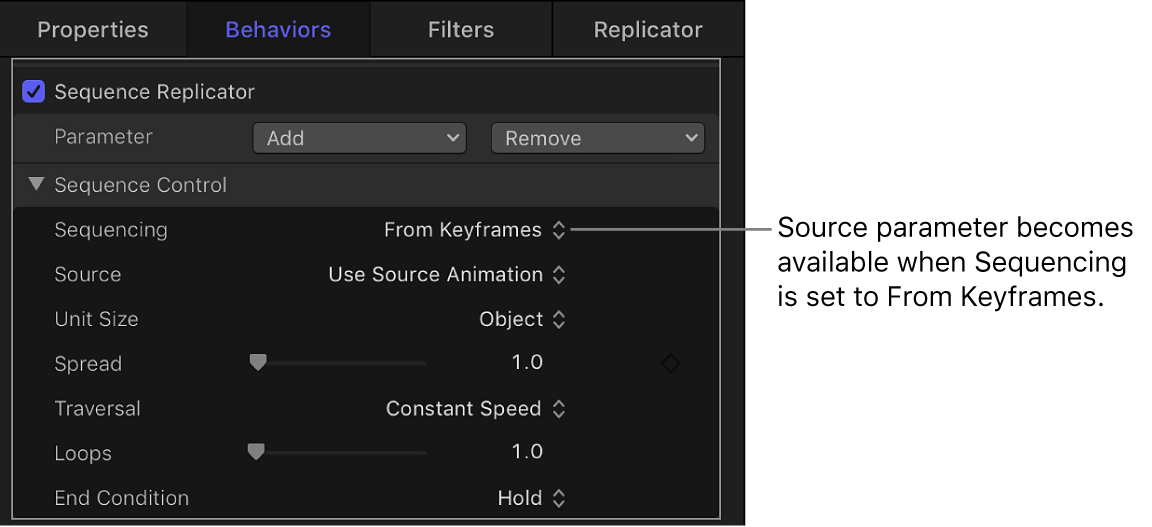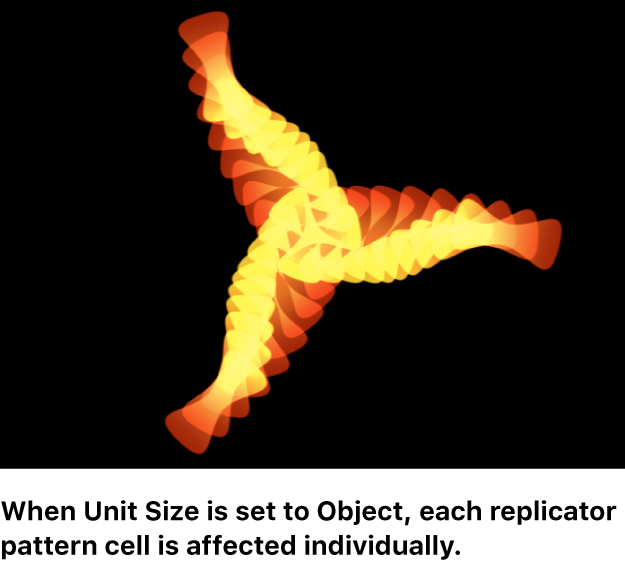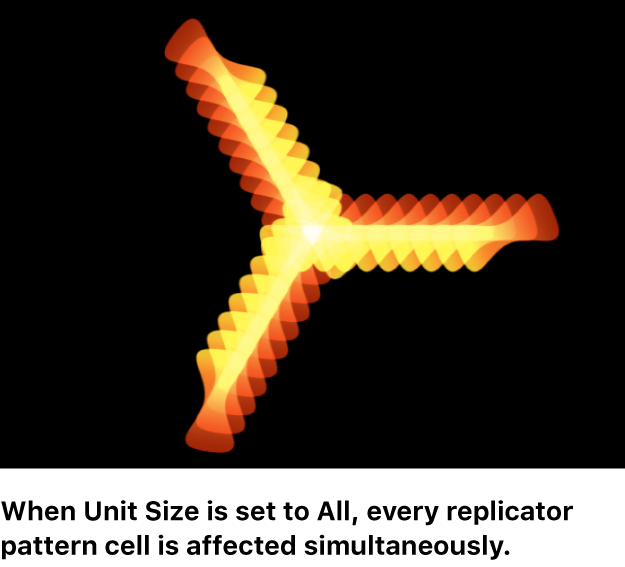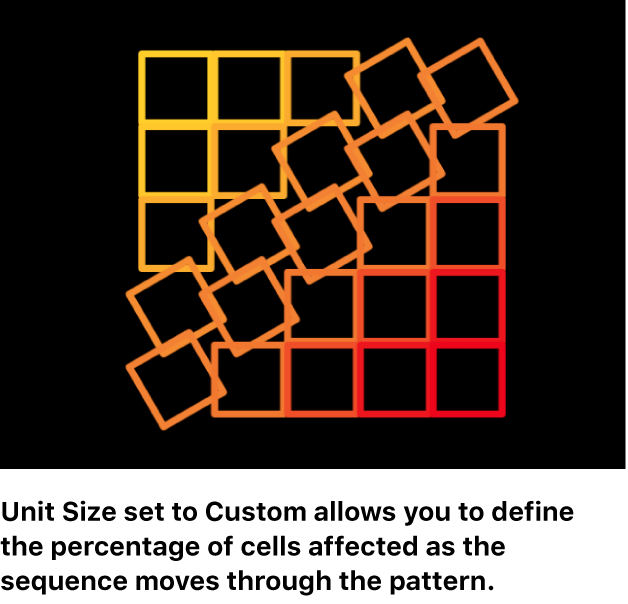Motion User Guide
- Welcome
- What’s new in Motion
-
- Intro to basic compositing
-
- Intro to transforming layers
-
- Intro to transforming layers in the canvas
- Transform layer properties in the canvas
- Transform tools
- Change layer position, scale, or rotation
- Move a layer’s anchor point
- Add a drop shadow to a layer
- Distort or shear a layer
- Crop a layer
- Modify shape or mask points
- Transform text glyphs and other object attributes
- Align layers in the canvas
- Transform layers in the HUD
- Transform 2D layers in 3D space
-
- Intro to behaviors
- Behaviors versus keyframes
-
- Intro to behavior types
-
- Intro to Parameter behaviors
- Audio behavior
- Average behavior
- Clamp behavior
- Custom behavior
- Add a Custom behavior
- Exponential behavior
- Link behavior
- Logarithmic behavior
- MIDI behavior
- Add a MIDI behavior
- Negate behavior
- Oscillate behavior
- Create a decaying oscillation
- Overshoot behavior
- Quantize behavior
- Ramp behavior
- Randomize behavior
- Rate behavior
- Reverse behavior
- Stop behavior
- Track behavior
- Wriggle behavior
-
- Intro to Simulation behaviors
- Align to Motion behavior
- Attracted To behavior
- Attractor behavior
- Drag behavior
- Drift Attracted To behavior
- Drift Attractor behavior
- Edge Collision behavior
- Gravity behavior
- Orbit Around behavior
- Random Motion behavior
- Repel behavior
- Repel From behavior
- Rotational Drag behavior
- Spring behavior
- Vortex behavior
- Wind behavior
- Additional behaviors
-
- Intro to using generators
- Add a generator
-
- Intro to image generators
- Caustics generator
- Cellular generator
- Checkerboard generator
- Clouds generator
- Color Solid generator
- Concentric Polka Dots generator
- Concentric Shapes generator
- Gradient generator
- Grid generator
- Japanese Pattern generator
- Lens Flare generator
- Manga Lines generator
- Membrane generator
- Noise generator
- One Color Ray generator
- Op Art 1 generator
- Op Art 2 generator
- Op Art 3 generator
- Overlapping Circles generator
- Radial Bars generator
- Soft Gradient generator
- Spirals generator
- Spiral Drawing generator
- Use Spiral Drawing onscreen controls
- Star generator
- Stripes generator
- Sunburst generator
- Truchet Tiles generator
- Two Color Ray generator
- Save a modified generator
-
- Intro to filters
- Browse and preview filters
- Apply or remove filters
-
- Intro to filter types
-
- Intro to Color filters
- Brightness filter
- Channel Mixer filter
- Color Adjustments filter
- Color Balance filter
- Example: Color-balance two layers
- Color Curves filter
- Use the Color Curves filter
- Color Reduce filter
- Color Wheels filter
- Use the Color Wheels filter
- Colorize filter
- Contrast filter
- Custom LUT filter
- Use the Custom LUT filter
- Gamma filter
- Gradient Colorize filter
- HDR Tools filter
- Hue/Saturation filter
- Hue/Saturation Curves filter
- Use the Hue/Saturation Curves filter
- Levels filter
- Negative filter
- OpenEXR Tone Map filter
- Sepia filter
- Threshold filter
- Tint filter
-
- Intro to Distortion filters
- Black Hole filter
- Bulge filter
- Bump Map filter
- Disc Warp filter
- Droplet filter
- Earthquake filter
- Fisheye filter
- Flop filter
- Fun House filter
- Glass Block filter
- Glass Distortion
- Insect Eye filter
- Mirror filter
- Page Curl filter
- Poke filter
- Polar filter
- Refraction filter
- Ring Lens filter
- Ripple filter
- Scrape filter
- Sliced Scale filter
- Use the Sliced Scale filter
- Sphere filter
- Starburst filter
- Stripes filter
- Target filter
- Tiny Planet filter
- Twirl filter
- Underwater filter
- Wave filter
-
- Intro to Stylize filters
- Add Noise filter
- Bad Film filter
- Bad TV filter
- Circle Screen filter
- Circles filter
- Color Emboss filter
- Comic filter
- Crystallize filter
- Edges filter
- Extrude filter
- Fill filter
- Halftone filter
- Hatched Screen filter
- Highpass filter
- Indent filter
- Line Art filter
- Line Screen filter
- MinMax filter
- Noise Dissolve filter
- Pixellate filter
- Posterize filter
- Relief filter
- Slit Scan filter
- Slit Tunnel filter
- Texture Screen filter
- Vignette filter
- Wavy Screen filter
- About filters and color processing
- Publish filter controls to Final Cut Pro
- Using filters on alpha channels
- Filter performance
- Save custom filters
-
- Intro to 3D objects
- Add a 3D object
- Move and rotate a 3D object
- Reposition a 3D object’s anchor point
- Exchange a 3D object file
- 3D object intersection and layer order
- Using cameras and lights with 3D objects
- Save custom 3D objects
- Guidelines for working with 3D objects
- Working with imported 3D objects
-
- Intro to 360-degree video
- 360-degree projects
- Create 360-degree projects
- Add 360-degree video to a project
- Create a tiny planet effect
- Reorient 360-degree media
- Creating 360-degree templates for Final Cut Pro
- 360-degree-aware filters and generators
- Export and share 360-degree projects
- Guidelines for better 360-degree projects
-
- Intro to settings and shortcuts
-
- Intro to Keyboard shortcuts
- Use function keys
- General keyboard shortcuts
- Audio list keyboard shortcuts
-
- Tools keyboard shortcuts
- Transform tool keyboard shortcuts
- Select/Transform tool keyboard shortcuts
- Crop tool keyboard shortcuts
- Edit Points tool keyboard shortcuts
- Edit shape tools keyboard shortcuts
- Pan and Zoom tools keyboard shortcuts
- Shape tools keyboard shortcuts
- Bezier tool keyboard shortcuts
- B-Spline tool keyboard shortcuts
- Paint Stroke tool keyboard shortcuts
- Text tool keyboard shortcuts
- Shape mask tools keyboard shortcuts
- Bezier Mask tool keyboard shortcuts
- B-Spline Mask tool keyboard shortcuts
- Transport control keyboard shortcuts
- View option keyboard shortcuts
- HUD keyboard shortcuts
- Inspector keyboard shortcuts
- Keyframe Editor keyboard shortcuts
- Layers keyboard shortcuts
- Library keyboard shortcuts
- Media list keyboard shortcuts
- Timeline keyboard shortcuts
- Keyframing keyboard shortcuts
- Shape and Mask keyboard shortcuts
- 3D keyboard shortcuts
- Miscellaneous keyboard shortcuts
- Touch Bar shortcuts
- Move assets to another computer
- Work with GPUs
- Glossary
- Copyright

Sequence Replicator controls in Motion
Use the following controls in the Behaviors Inspector to modify the sequence animation:
Parameter: Two pop-up menus (Add and Remove) that designate pattern elements to animate in sequence. When you choose an item from the Add pop-up menu, additional controls appear at the top of the Behaviors Inspector. You can adjust these controls (or keyframe them) to modify the sequence animation, which is based on the change in value between these parameters and the original values of the cells. The Add pop-up menu items include the following options:
Rotation: Adds a rotation dial and value slider to specify (in degrees) the rotation of replicator elements.
Color: Adds a row of color controls to set a tint for replicator elements. Click the color well to choose a color or open the disclosure triangle and adjust the Red, Green, and Blue sliders. For more information about using color controls, see Use basic color controls in Motion.
Opacity: Adds an opacity slider to define the transparency of the pattern elements.
Scale: Adds a scale slider to define the size of replicator elements. Click the disclosure triangle next to the Scale parameter to reveal separate X, Y, and Z scaling subparameters. Use X and Y to resize the width and height of elements separately; use Z to change the depth of 3D text elements. By default, Scale is set to 100%—the size of the replicator cells is equal to the original size defined in the cell parameters.
Position: Adds two value fields that define the offset of elements from their original position in X and Y space. Click the disclosure triangle next to the parameter name to reveal separate X, Y, and Z position subparameters. For example, to create an animation in which elements move upward along the Y axis over the replicator pattern, enter a positive value in the Y Position field. In the following images, Y Position is set to 300.

Sequencing: A pop-up menu to set how the sequence animation moves through the elements of the pattern, based on the change from the original parameter value to the value set in the Sequence Replicator parameters. The starting point for the sequence animation is based on the selected Origin or Build Style parameters (in the Replicator Inspector). For example, if a line replicator’s Origin parameter is set to End Point, the sequence animation begins at the end of the line and moves toward the start of the line by default. To change the starting point for the sequence animation, change the Origin or Build Style of the pattern in the Replicator Inspector or HUD. The Sequencing pop-up menu contains the following options:
To: Animation begins at the original value of the cells and moves to the value set in the Sequence Replicator behavior for that parameter. For example, if the original opacity value of a cell is 100%, and opacity is set to 0% in the Sequence Replicator parameters, onscreen elements begin completely opaque and become completely transparent.
From: Animation moves from the value set in the Sequence Replicator behavior to the original value of the cells. For example, if the original opacity value of a cell is 100% and opacity is set to 0% in the Sequence Replicator parameters, onscreen elements begin completely transparent and become completely opaque. This is the opposite of the To option in the Sequencing pop-up menu.
Through: The sequence goes through a full animation cycle starting at the original value of the cells, moving to the value set in the Sequence Replicator, and then returning to the original value of the cells. For example, if the original opacity value of a cell is 100% and opacity is set to 0% in the Sequence Replicator parameters, onscreen elements begin completely opaque, become transparent, and then become completely opaque again.
Through Inverted: The sequence goes through an inverted animation cycle starting from the value set in the Sequence Replicator, moving to the original value of the cells, and then returning to the value set in the Sequence Replicator. For example, if the original opacity value of a cell is 100% and opacity is set to 0% in the Sequence Replicator parameters, the onscreen elements begin completely transparent, become opaque, and then become completely transparent. This is the opposite of the Through Sequencing option.
From Keyframes: Lets you use animation created in the source layer’s parameters (except alpha parameters). Additionally, you can keyframe how the animation moves through the values set in the Sequence Replicator parameters.

Source: A pop-up menu (available when the Sequencing pop-up menu is set to From Keyframes) to enable animation created by keyframes in a replicated source layer (the layer that’s disabled when the replicator is created). There are two options: Use Source Animation and Ignore Source Animation.
Unit Size: A pop-up menu to specify whether the sequence animation is applied to the replicator pattern as a whole, to its elements, or to a keyframed range. There are three options:
Object: The default setting, applies the animation to each element in sequence over the duration of the behavior.

All: Applies the sequence animation to all replicator elements simultaneously.

Custom: Lets you specify the percentage of elements in the pattern affected by the sequence animation simultaneously. As shown in the following images, the Object and All options allow you to sequence the animation through the origin or build style of the pattern, or through all pattern elements simultaneously.

When you choose Custom from the Unit Size pop-up menu, the Start and End parameters (described below) become available.
Start: A slider (available when the Unit Size pop-up menu is set to Custom) to specify the offset of the start of the range of elements affected by the sequence animation. In the above image, Start is set to 10%.
End: A slider (available when the Unit Size pop-up menu is set to Custom) to specify the end of the range of elements affected by the sequence animation. By default, End is set to 10%. In the above image, End is set to 30%.
Note: If the Sequencing pop-up menu is set to From Keyframes, the Custom option in the Unit Size parameter has no affect.
Spread: A slider to control the amount of falloff of the animation. To create a softer transition between each element, increase the Spread value.
Traversal: A pop-up menu to set the action of the sequence behavior to one of the following:
Constant Speed: The sequence animation moves from the origin of the replicator pattern through the end of the pattern at a constant speed. The sequence moves in the direction specified in the Replicator Inspector (such as Origin or Build Style).
Ease In: The sequence animation begins slowly and increases to normal speed as it moves through the replicator pattern.
Ease Out: The sequence animation begins at normal speed and slows toward the end of the replicator pattern.
Ease In/Out: The sequence animation begins slowly, increases to normal speed as it moves toward the middle of the duration of the replicator pattern, then slows as it reaches the end of the replicator pattern.
Accelerate: The sequence animation increases in speed.
Decelerate: The sequence animation decreases in speed.
Custom: This option lets you keyframe how the animation moves through the replicator pattern. When the Traversal pop-up menu is set to Custom, the Location parameter replaces the Loops parameter.
Location: A slider (available when Traversal is set to Custom) to define where on the pattern the animation is in effect.
For more information on using the Custom Traversal option, see Control sequence timing with keyframes in Motion.
Loops: A slider to set the number of times the animation sequences through the replicator pattern over its duration.
Note: Loops is not available when the Traversal parameter is set to Custom.
End Condition: A pop-up menu that sets how the sequence animation is repeated over the duration of the replicator object. This parameter has no effect for Loop values less than or equal to 1. There are three End Condition options:
Hold: Completes the sequence animation cycle one time, then starts it again from the beginning (after the last element in the sequence completes its animation).
Wrap: Treats the sequence animation as a continuous loop so the spread wraps from the last element in the sequence to the first element.
Ping Pong: Completes the sequence animation cycle forward, then completes the animation backward, then forward, and so on.
Download this guide: PDF